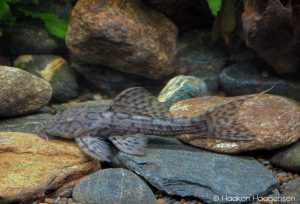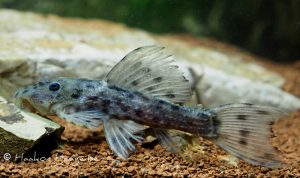The next issue of the BSSW-Report (03-2020) will cover a species of Pseudacanthicus, that really provoked some discussions and exclamations in the hobby lately. Therefore, it only seems legit to republish a short piece about a species of similar interest from a former Report (03-2019).
Pseudacanthicus sp. “L 79” was given its code number in 1991, it was discovered in the north-east of Brazil, in the lower reaches of the Rio Tocantins near Marabá. This catfish is wrongfully called Pseudacanthicus cf. spinosus on various websites. This is clearly wrong since it has a completely different body shape. Pseudacanthicus spinosus is much plumper and its back is a lot higher than that of the overall rather flat Pseudacanthicus sp. “L 79”. Moreover, the iris colour is different: In Pseudacanthicus sp. “L 79”, it is light in colour, and, according to an article published in the DATZ magazine, it is silvery-shiny, whereas the iris of Pseudacanthicus spinosus is dark brown.Due to its supposedly low attractiveness and high price, as well as an export ban, it has not been imported into Europe in recent years. This led to the fact that not even a handful of private persons fulfilled their dream of caring for the animals and ordered them by detour from Singapore. All these individuals originally came from the Rio Tocantins.
Only recently a few animals of this species could be commercially imported into Europe again, with the addition “Rio Xingu”. However, these animals were not proven on the spot. Also, the imported animals do not differ from those which are already known from the Rio Tocantins, which raises some questions. Namely whether these animals come at all from the Rio Xingu, which can, based on current knowledge, be excluded after consultation with scientists who examine the Rio Xingu. It is known, however, that recently “forbidden” animals could be legally exported for export. This was also the case with Ancistrus sp. “L 255”, allegedly whole areas or river sections are released, which would make it possible to get a Pseudacanthicus with the addition “Rio Xingu” more or less legally. However, correct, and up-to-date information are not available at the moment.As you can see, some questions remain unanswered. Nevertheless, we should enjoy these interesting animals.
Literature: Stawikowski, R. (1991): Neu importiert: Tocantins- und Xingu-Harnischwelse (DATZ 44 (13) 143-144)
Text: Markus KALUZA – Pictures: Haakon HAAGENSEN

